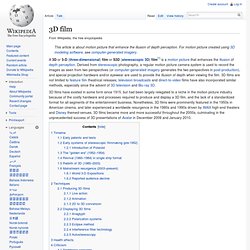

3-D film. A 3D or 3-D (three-dimensional) film or S3D (stereoscopic 3D) film[1] is a motion picture that enhances the illusion of depth perception.

Derived from stereoscopic photography, a regular motion picture camera system is used to record the images as seen from two perspectives (or computer-generated imagery generates the two perspectives in post-production), and special projection hardware and/or eyewear are used to provide the illusion of depth when viewing the film. 3D films are not limited to feature film theatrical releases; television broadcasts and direct-to-video films have also incorporated similar methods, especially since the advent of 3D television and Blu-ray 3D.
Timeline[edit] Early patents and tests[edit] Joy stereoscopic era of motion pictures began in the late 1890s when British film pioneer William Friese-Greene filed a patent for a 3D movie process. In his patent, two films were projected side by side on screen. Early systems of stereoscopic filmmaking (pre-1952)[edit] Depth perception. Perspective, relative size, occlusion and texture gradients all contribute to the three-dimensional appearance of this photo.

Depth perception is the visual ability to perceive the world in three dimensions (3D) and the distance of an object. Depth sensation is the corresponding term for animals, since although it is known that animals can sense the distance of an object (because of their ability to move accurately, or to respond consistently, according to that distance), it is not known whether they "perceive" it in the same subjective way that humans do.[1] Depth perception arises from a variety of depth cues. These are typically classified into binocular cues that are based on the receipt of sensory information in three dimensions from both eyes and monocular cues that can be represented in just two dimensions and observed with just one eye.[2][3] Binocular cues include stereopsis, eye convergence, disparity, and yielding depth from binocular vision through exploitation of parallax.
"Can't See 3D in Avatar movie? People with 3-D Eye Problems? Hea. Avatar 3D Movie Falls Flat for People Who Can Not See with Both Eyes at the Same Time (Stereovision) How to See Avatar 3-D -- It Takes Two Eyes to Tango!

Are you or your kid wondering what everyone is oohing and aahing about when watching the Avatar 3D movie or other 3-D films? Or does 3D viewing cause you or someone you know to experience headaches, stomachaches, motion sickness, confusion, or boredom...? In order to view 3D stereo images (in 3-D movies, 3-D posters, pictures, books, etc.) you must have two eyes that work together simultaneously as a coordinated team. Two working eyes are definitely required! Looking in the mirror to make sure you have two eyes and that they are both open at the same time is NOT an adequate inspection of your 3D viewing equipment.
Consider testing your own binocular vision with The Framing Game and The Eye Hop Game for starters. Even if it turns out that you do have a problem with your two-eyed vision, don't worry! "Test Your Vision. Binocular? Stereoscopic?" Small interaxials. Caméra 3D Panasonic Test Appareil Photo Numérique. Caméra 3D Panasonic offrira un calibrage automatique Le système d’optiques jumelles adopté par Panasonic permet d’ajuster le point de convergence et propose des fonctions de correction automatique des déplacements horizontaux et verticaux.

Les systèmes 3D classiques nécessitent que ces ajustements soient réalisés par le biais d’un PC ou d’un processeur vidéo externe. La nouvelle caméra Panasonic offrira un calibrage automatique qui s’effectuera sans avoir recours à un équipement externe, et permettra ainsi la captation immédiate d’images 3D avec un minimum de matériel. Caméra Panasonic 3D pour la captation d’événements sportifs Le système d’enregistrement sur mémoire flash offre une plus grande flexibilité lors des tournages en environnements difficiles. La nouvelle caméra 3D Panasonic est bien plus légère et plus compacte que les plateformes 3D actuelles, et offre toute les possibilités de prise de vue d’une caméra de poing. Professional Cine Equipment Manufacture.